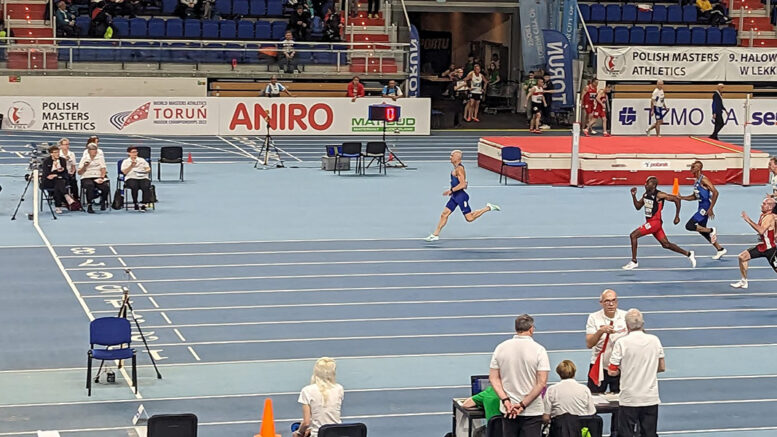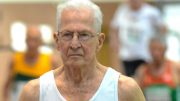Forget Dr. Delano Meriwether, the iconic sprinting medical doc of the early 1970s. My favorite fast physician is Dr. Allan Tissenbaum of Pittsburgh, whose up-and-down (via injury) career I’ve followed for decades. At the recent Torun world indoor meet, Dr. T took M60 60 gold in 7.71 seconds. (I’m predicting he’ll win the M100 100 outdoor title in four decades.) That is, if he can heal up from his myriad injuries. In Poland, he attempted only the short dash, saying he was dealing with “nerve upper extremity stuff.” No matter. His heart and mind were all right. Upon his return Tuesday, he posted an amazing essay. He graciously allowed me to reprint it from Facebook. He’s a champion of The Tribe as well.
Dr. T writes:
We spent the better part of the last two weeks in Poland. The visit was twofold: I competed in the World Masters Track and Field Championships in Toruń. It was very important to me as a Jew who has lived with the Holocaust and the consequences for as long as I have been alive.
My maternal grandparents Albert and Hedda De Jonge both were murdered — one in Auschwitz, the other Sorbibor. I felt that by just competing in Poland I would feel some sense of redemption.
Unfortunately, that was not the case. It did feel nice to compete well, but my overwhelming sense everywhere we went while trying to identify and find traces of a Jewish community that was over 3 million people prior to to Nazi attempt of complete genocide was one of great loss and grief.
While there are traces of the Jewish community and valiant attempts to rebuild and re-energize, the truth is there is very little Jewish life in Poland. In Warsaw, we went to the only surviving Jewish synagogue that was not destroyed by the Nazis. It only survived because the Nazis use it as a stable for their horses.
Shabbat services were very meaningful, but the community is very small. We were led through part of the service by Cantor Yaakov Lemmer, who has one of the greatest voices I have ever had the privilege to hear.
There are valiant efforts made by people like Rabbi Schudrich to keep the community alive and help it grow.
We spent the next five days in the beautiful town of Torun, where I competed in the 60-meter dash. Once the competition was over, we returned to Warsaw to try and trace and had a guide take us through the Jewish sites that remain in Warsaw.
Warsaw was almost completely destroyed in WWII, but much of it has been rebuilt. The city was home to over 350,000 Jews. The actual number that is present now is small.
We were taken to the site of the Warsaw Ghetto Uprising; there is very little physical evidence of the uprising or of the Jewish ghetto that housed up to 450,000 Jews during the war.
Almost every one of the Jews was liquidated in death camps. We saw the famous remnants of the Bunker Mila 18.
The majority of where the Ghetto was located has been plowed over and new residences were built right over the tops of this mass grave.
There is a small piece of the Ghetto wall that survived with a small memorial that is very difficult to find. From there we next went to a museum of Polish Jewish history, which leads to the path the Jews were forced to march along to take them to the cattle cars on their way to the gas chambers.
It is thought that 300,000 Jews met their end after this march.
Krakow was next. It is a gorgeous vibrant city that at one point had a thriving Jewish community. The Jewish community is growing there at this moment and a lot of work is being done through a very impressive JCC.
They have done a lot of work with Ukrainian refugees, feeding, clothing them and providing other services. The JCC appears to be the center of present-day Jewish life in Krakow. They’re doing a great job in outreach and making a very serious attempt to grow the community and educate all about historic and present Jewish life.
We went to the Galicia museum, which had a lot of information about Jewish life in Poland pre and post WWII.
The following day we spent at Auschwitz Birkenau, which was the extermination facility where over 1 million jews met their end. Many of the prisoners prior to execution were tortured, beaten physically and sexually abused, experimented upon and forced to perform unthinkable acts prior to their execution.
We walked along the ruins of the camp, but some parts were still intact. Most of the barracks that housed the prisoners along with the gas chambers and crematoriums had been destroyed by the Nazis as they were fleeing the advancing Russian troops.
The selection platform where life or death was decided for millions was still intact. It was here where German officers decided who would meet immediate death and be marched right to the gas chambers and who would be made to do slave labor.
For me, this was an out-of-body experience. I was standing in the exact place my grandparents had stood 80 years ago before they met their end. We were then marched to the women’s barracks and I know that my grandmother met her end in one of these barracks.
We arrived at the camps at 8 a.m. It was rainy and cold 34F or 2C. It was windy, and we were completely out in the open, but none of us dare complained. It was simple to imagine being in a similar place 80 years earlier with only thin poorly made pajamas for cover, ill fitting or no shoeware and suffering from malnutrition from the caloric restriction. Most of the prisoners received less than 200 calories per day.
With no real hope for any possible improvement in the living conditions with the exception of death.
The timing of our trip was not lost on us either. This is the week we Jews celebrate Passover — one of the many times the Jewish peoplehood had to overcome slavery and attempts at mass extermination. Given the current unprecedented rise in antisemitism, this should give us all pause to stop and reflect.
Leaving Auschwitz, I felt like I was leaving part of my past — but at the same time felt much more connected to this part of my history.
What happened to the Jewish people and all others who suffered at the hands of the Nazis was and is unthinkable — we can never let anything like this happen again.
For me, I believed prior to going to Poland that I would find some personal redemption by competing as a Jew and hopefully coming away with a medal. But the biggest sentiment I felt after being in Poland was the sense of such great loss, 3 million Jews lost their lives there and there can really never be any redemption.
Contribute to support independent track and field journalism:






Very, very impressive essay by our friend Dr. Allan T. Even 100 years from now (in 2123) people will be revisiting what happened at Auschwitz, Dachau, and the other scenes of mass extermination of Jewish people and other targeted men and women during the years before World War II. We can never forget.
Just to edit my contribution above just a bit, we know that gay men (“homosexuals” in the parlance of the day) were definitely targeted by the Nazis, but I can find no evidence that they were given death sentences.